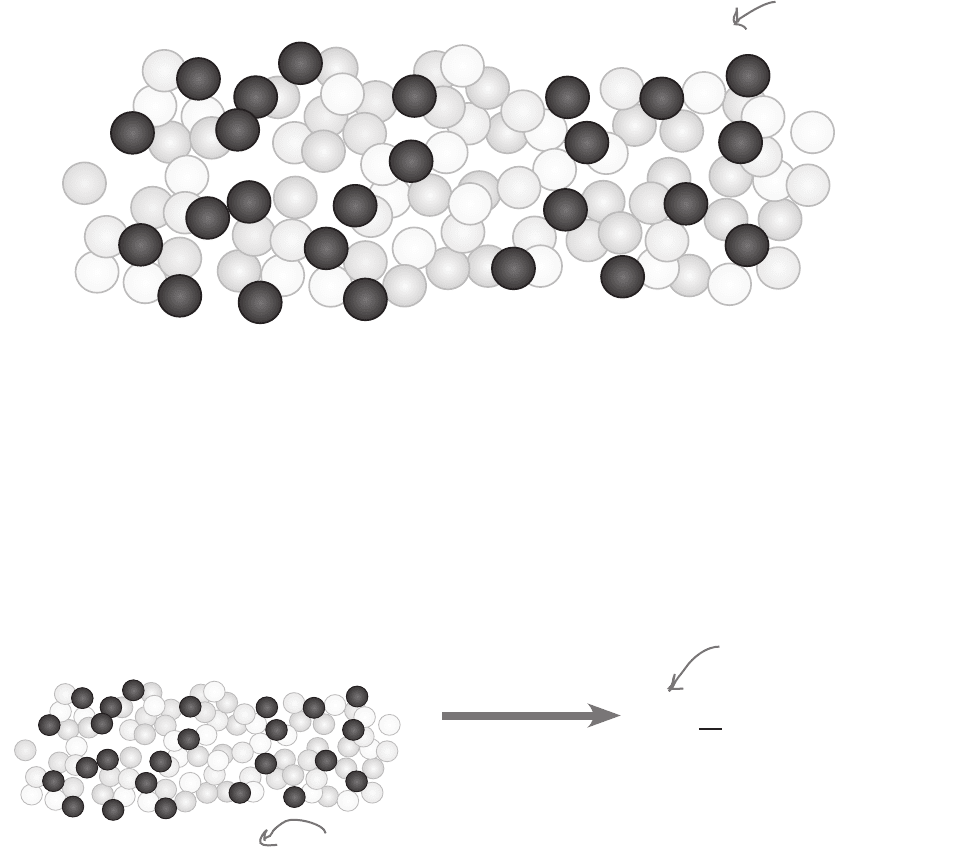Griffiths D. Head First Statistics
Подождите немного. Документ загружается.


you are here 4 451
estimating populations and samples
Some books tell you to
divide by n – 1 for a
sample, and some tell
you to divide by n.
This is because different
books make different assumptions about
what you’re using your sample for. If
you’re using the sample to estimate the
population variance, then you need to
divide by n – 1. You only need to divide
by n if you want to calculate the variance
of that exact set of values.
If you’re taking a statistics exam, check
the approach that your exam board takes.
Which formula’s which?
Sometimes it can be tricky deciding whether you should
divide by n for the variance, or whether you should divide by
n – 1. The golden rule to remember is that dividing by n gives
you the actual variance for the set of data that you
have.
If you have the data for the entire population, then dividing
by n gives you the actual variance of the population. You
need to use the formula for σ
2
and divide by n.
If you have a sample of data from the population, then
chances are you’ll want to use this to estimate the variance of
the population. This means that you need to use the formula
for s
2
and divide by n – 1.
Here’s a reminder of the data from the Mighty Gumball sample.
What do you estimate the population variance to be?
61.9 62.6 63.3 64.8 65.1 66.4 67.1 67.2 68.7 69.9

452 Chapter 11
Here’s a reminder of the data from the Mighty Gumball sample.
What do you estimate the population variance to be?
61.9 62.6 63.3 64.8 65.1 66.4 67.1 67.2 68.7 69.9
We can estimate the population variance by calculating s
2
.
σ
2
= s
2
= (x - x)
2
n - 1
= (-3.8)
2
+ (-3.1)
2
+ (-2.4)
2
+ (-0.9)
2
+ (-0.6)
2
+ (0.7)
2
+ (1.4)
2
+ (1.5)
2
+ (3)
2
+ (4.2)
2
9
= 14.44 + 9.61 + 5.76 + 0.81 + 0.36 + 0.49 + 1.96 + 2.25 + 9 + 17.64
9
= 62.32/9
= 6.92 (to 2 decimal places)
^
Q:
Why do I divide by n – 1 for the
sample variance? Why can’t I divide by
n?
A: You divide by n – 1 for a sample
because most of the time, you use your
sample data to estimate the variance of the
population. Dividing by n – 1 gives you a
slightly more accurate result than dividing by
n. This is because the variance of values in
the sample is likely to be slightly lower than
the population variance.
Q:
Is there some mathematical basis
for this?
A: Yes there is. It’s something that we’re
going to touch upon at the end of the chapter,
but hold onto that thought; it’s a good one.
Q:
How do I remember which symbols
are used for the population, and which
are used for the sample?
A: In general, Greek letters are used for
the population, and normal Roman letters
are used for the mean and variance for the
sample.
Q:
Is there a point estimator for the
standard deviation in the same way that
there is for the variance? How do I find it?
A: If you need to estimate the standard
deviation, start by calculating the estimator
for the variance. The estimator for the
standard deviation is the square root of this.
more solutions and questions

you are here 4 453
estimating populations and samples
Mighty Gumball has done more sampling
The Mighty Gumball CEO is so inspired by the results of the taste test that
he’s asked for another sampling exercise that he can use for his television
advertisements. This time, the CEO wants to be able to say how popular
Mighty Gumball’s candy is compared with that of their main rival.
The Mighty Gumball staff have asked a random sample of people whether
they prefer gumballs produced by Mighty Gumball or whether they prefer
those of their main rival. They’re hoping they can use the results to predict
what proportion of the population is likely to prefer Mighty Gumball.
Mighty Gumball has found that in a sample of 40 people, 32 of them prefer
their gumballs. The other 8 prefer those of their rival.
How would you find the proportion of people in the sample who prefer Mighty
Gumball’s candy? What distribution do you think this follows? How do you think
you could apply this to the population?
Ewww! These
gumballs are gross.
I’ll choose Mighty
Gumball over any
other manufacturer.

454 Chapter 11
It’s a question of proportion
For the latest Mighty Gumball sample, the thing the CEO is interested in is
whether or not each person prefers Mighty Gumball confectionery to that of
their chief rival. In other words, every person who prefers Mighty Gumball
candy can be classified as a success.
So how do we use the sample data to predict the proportion of successes in
the population?
Predicting population proportion
If we use X to represent the number of successes in the population, then X
follows a binomial distribution with parameters n and p. n is the number of
people in the population, and p is the proportion of successes.
In the same way that our best estimate of the population mean is the
mean of the sample, our best guess for the proportion of successes in the
population has to be the proportion of successes in the sample. This means
that if we can find the proportion of people in the sample who prefer Mighty
Gumball’s treats, we’ll have a good estimate for the proportion of people who
prefer Mighty Gumball in the general population.
We can find the proportion of successes in the sample by taking the total
number of people who prefer Mighty Gumball, and then dividing by
the total number of people in the sample. If we use p
s
to represent the
proportion of successes in the sample, then we can estimate the proportion of
successes in the population using
p = p
s
^
In other words, we can use the proportion of successes in the sample as a
point estimator for the proportion of successes in the population. In the case
of the company’s latest sample, 32 out of 40 people prefer Mighty Gumball
confectionery, which means that p
s
= 0.8. Therefore, the point estimator for
the proportion of successes in the population is also 0.8.
where
p
s
= number of successes
number in sample
Proportion of successes in the
sample
Point estimator for the proportion
of successes in the population
point estimators for proportions

you are here 4 455
estimating populations and samples
Probability and proportion are related
There’s actually a very close relationship between probability and
proportion.
Imagine you have a population for which you want to find the
proportion of successes. To calculate this proportion, you take the
number of successes, and divide by the size of the population.
Now suppose you want to calculate the probability of choosing a
success from the population at random. To derive this probability,
you take the number of successes in the population, and divide
by the size of the population. In other words, you derive the
probability of getting a success in exactly the same way
as you derive the proportion of successes.
We use the letter p to represent the probability of success in the
population, but we could easily use p to represent proportion
instead—they have the same value.
p = probability = proportion
So am I right in thinking that
probability and proportion are
related? They’re both represented by
p, and they sound like they’re similar.
Mighty Gumball takes another sample of their super-long-lasting
gumballs, and finds that in the sample, 10 out of 40 people prefer
the pink gumballs to all other colors. What proportion of people
prefer pink gumballs in the population? What’s the probability of
choosing someone from the population who doesn’t prefer pink
gumballs?

456 Chapter 11
Mighty Gumball takes another sample of their super-long-lasting
gumballs, and finds that in the sample, 10 out of 40 people prefer
the pink gumballs to all other colors. What proportion of people
prefer pink gumballs in the population? What’s the probability of
choosing someone from the population who doesn’t prefer pink
gumballs?
We can estimate the population proportion with the sample proportion. This gives us
p = p
s
= 10/40
= 0.25
The probability of choosing someone from the population who doesn’t prefer pink gumballs is
P(Preference not Pink) = 1 - p
= 1 - 0.25
= 0.75
^
^
Q:
So is proportion the same thing as
probability?
A: The proportion is the number of
successes in your population, divided by
the size of your population. This is the
same calculation you would use to calculate
probability for a binomial distribution.
Q:
Does proportion just apply to the
binomial distribution? What about other
probability distributions?
A: Out of all the probability distributions
we’ve covered, the only one which has
any bearing on proportion is the binomial
distribution. It’s specific to the sorts of
problems you have with this distribution.
Q:
Is the proportion of the sample the
same as the proportion of the population?
A: The proportion of the sample can be
used as a point estimator for the proportion
of the population. It’s effectively a best
guess as to what the value of the population
proportion is.
Q:
Is that still the case if the sample is
biased in some way? How do I estimate
proportion from a biased sample?
A: The key here is to make sure that
your sample is unbiased, as this is what you
base your estimate on. If your sample is
biased, this means that you will come with
an inaccurate estimate for the population
proportion. This is the case with other point
estimators too.
Q:
So how do I make sure my sample
is unbiased?
A: Going through the points we
raised in the previous chapter is a good
way of making sure your sample is as
representative as possible. The hard work
you put in to preparing your sample is
worth it because it means that your point
estimators are a more accurate reflection of
the population itself.
yet more solutions and questions

you are here 4 457
estimating populations and samples
This is awesome!
We have a lot of
impressive statistics
we can use in our
advertising.
10
40
people
prefer
pink!
The point estimator for the population
variance is given by
σ
2
= s
2
where s
2
is given by
Σ(x - x)
2
n - 1
The population proportion is represented
using p. It’s the proportion of successes within
the population.
The point estimator for p is given by p
s
,
where p
s
is the proportion of successes in the
sample.
p = p
s
You calculate p
s
by dividing the number of
successes in the sample by the size of the
sample.
p
s
= number of successes
number in sample
^
^

458 Chapter 11
Buy your gumballs here!
Remember the Statsville Cinema? They’re recently been authorized
to sell Mighty Gumball products to film-goers, and it’s a move that’s
proving popular with most of their customers.
The trouble is, not everybody’s happy.
I really like red gumballs,
and I’d rather not eat the
other colors. How many red
gumballs come in the box?
Introducing new jumbo boxes
The cinema sells mixed boxes of gumballs, and this weekend,
they’re putting on a film marathon of classic films.
The event looks like it’s going to be popular, and tickets are selling
well. The trouble is, some people get cranky if they don’t get their
fix of red gumballs.
A jumbo box of gumballs is meant for sharing, and each box
contains 100 gumballs. 25% of gumballs in the entire gumball
population are red.
I need 40 red gumballs to
make it through the movie.
Is that likely? If there
aren’t enough red gumballs in
the box, I’ll get another snack
instead.
We need to find the probability that in one
particular jumbo box, 40 or more of the
gumballs will be red.
Since there are 100 gumballs per box, that means we need
to find the probability that 40% of the gumballs in this box
are red, given that 25% of the gumball population is red.
finding sample probabilities

you are here 4 459
estimating populations and samples
So how does this relate to sampling?
So far, we’ve looked at how to put together an unbiased sample, and
how to use samples to find point estimators for population parameters.
This time around, the situation’s different. Here, we’re told what the
population parameters are, and we have to work out probabilities
for one particular jumbo box of gumballs. In other words, instead
of working out probabilities for the population, we need to work out
probabilities for the sample proportion.
Isn’t that the sort of thing
that we were doing before?
What’s the big deal?
This time, we’re looking for probabilities for a
sample, not a population.
Rather than work out the probability of getting particular frequencies
or values in a probability distribution, this time around we need to find
probabilities for the sample proportion itself. We need to figure
out the probability of getting this particular result in this particular box
of gumballs.
Before we can work out probabilities for this, we need to figure out the
probability distribution for the sample proportion. Here’s what we need
to do:
Look at all possible samples the same size as the one we’re
considering.
If we have a sample of size n, we need to consider all possible samples of
size n. There are 100 gumballs in the box, so in this case n is 100.
11
Look at the distribution formed by all the samples, and
find the expectation and variance for the proportion.
Every sample is different, so the proportion of red gumballs in each box
of gumballs will probably vary.
22
Once we know how the proportion is distributed, use it to
find probabilities.
Knowing how the proportion of successes in a sample is distributed
means we can use it to find probabilities for the proportion in a random
sample—in this case, a jumbo box of gumballs.
33
Let’s take a look at how to do this.

460 Chapter 11
Sample
The sampling distribution of proportions
So how do we find the distribution of the sample proportions?
Let’s start with the gumball population. We’ve been told what the
proportion of red gumballs is in the population, and we can represent
this as p. In other words, p = 0.25.
Each jumbo box of gumballs is effectively a sample of gumballs taken from the
population. Each box contains 100 gumballs, so the sample size is 100. Let’s
represent this with n.
If we use the random variable X to represent the number of red gumballs in
the sample, then X ~ B(n, p), where n = 100 and p = 0.25.
The proportion of red gumballs in the sample depends on X, the number of
red gumballs in the sample. This means that the proportion itself is a random
variable. We can write this as P
s
, where P
s
= X/n
P
s
= X
n
X ~ B(n, p)
We don’t know the exact number
of red gumballs in the sample, but
we know its distribution.
P
s
represents the proportion
of successes in the sample.
25% of gumballs in the
gumball population are red,
so p = 0.25.
Population of gumballs
distribution of sample proportions
